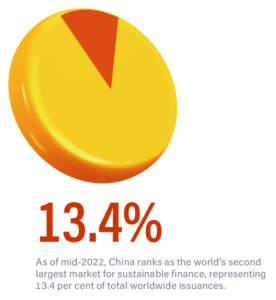
Options to fund the path to carbon neutrality
According to the Climate Policy Initiative, in order to meet the Paris Agreement targets, investments of between United States dollars (USD)1.6–3.8 trillion will be required annually until 2050. Following China’s declaration of its commitment to fighting climate change and achieving carbon neutrality by 2060, sustainability has become a consensus and a major objective. Clement Lecroart of Crédit Agricole CIB China Limited looks at the innovation capabilities developed by the finance industry.
China’s critical role in a growing ESG bond market
A strong worldwide trend towards supporting sustainable and social initiatives emerged in 2021. The volume of green, social, sustainability and sustainability-linked bond issuances in 2021 was approximately USD 927 billion, up 117 per cent year-on-year. In addition, this volume represents 8.4 per cent of 2021’s total global bond issuance, compared to 4.1 per cent in 2019, highlighting how environmental, social and governance (ESG) demands are becoming ever-more relevant for both issuers and investors. While the market is still driven by green bonds (accounting for around 55 per cent), the social and sustainable bonds market has seen significant growth globally amid COVID-19.

China has an essential role to play in the evolving ESG bond market. As of mid-2022, China ranks as the world’s second largest market for sustainable finance, representing 13.4 per cent of total worldwide issuances (vs. 9.2 per cent in 2021).[1] In addition, China was the first country to launch governmental guidelines for green bond issuances, alongside an official catalogue on the taxonomies of eligible projects to be financed by the government.
Sustainability requires long-term planning, contributions by various stakeholders
For many banks, ESG has long been part of their strategy. Banks have been deeply engaged in major international climate finance and sustainable initiatives, including the Equator Principles, which provides a social and environmental risk management platform for financial institutions,[2] the Climate Principles code of conduct,[3] and the Net Zero Banking Association, as well as in defining the Green Bond and Sustainability Principles. The aim behind the banks’ cooperation is to actively contribute to a more sustainable world and support the energy transition by cooperating and engaging with regulators and public authorities, leveraging their expertise to promote ESG solutions.
In China, the regulators have made a lot of progress in promoting sustainability. For instance, in 2021, the People’s Bank of China (PBOC) published a new set of measures for assessing financial institutions’ performance in developing and promoting green finance. The PBOC also launched a carbon emissions reduction facility in November 2021, providing a means for low-cost loans to Chinese financial institutions through a carbon reduction support tool, while setting guidelines for lenders to focus on when dealing with borrowers from fields target for certain carbon-reduction.
Several other initiatives have been taken by the banking industry, such as the Green Investment Principles for the Belt and Road Initiative, which promote sustainable finance and ensure that those projects are aligned with ESG principles and the climate goals of the Paris Agreement.
Continuous innovation a catalyst for driving sustainable development
Innovation is key to integrating ESG elements into banking products and is fostered thanks to the implementation of new practices, favourable policy support from the authorities and keen investors appetite.
The trend started with green bonds, which enable specified green projects to be funded. A green bond shows a commitment to exclusively use the funds raised to finance sustainable projects, assets or business activities. Other thematic labels, such as COVID-19 bonds and blue bonds, have emerged to illustrate the sustainability focus of corporations and transactions.
Green loans have followed the same innovative principles. The finance industry has been widening and enriching its sustainable product offerings, such as sustainability-linked derivatives, green deposits, green guarantees and green securitisation.
A sustainable future requires joint collaboration
The European and Chinese finance industries should continue to cooperate in order to harmonise the EU Taxonomy and the PBOC Principles. With robust involvement and cooperation by regulators, issuers, investors and banking partners, a sustainable future that provides a collective green footprint for the industry can be built.
In Europe, the EU Taxonomy Regulation is one of the most significant developments in sustainable finance. It creates an acknowledged system for economic activities and providing clarity on what should be defined as ‘green’ and ‘sustainable’. Meanwhile, China unified domestic standards for green bonds by adopting more scientific and precise definitions relating to green projects.[4]
In July 2020, the EU and China initiated a working group on taxonomies, with the objective of undertaking a comprehensive assessment of the two sides’ existing taxonomies for sustainable investments, including identifying any commonalities and differences. The Common Ground Taxonomy (CGT) was released in November 2021, serving as an important cornerstone in the journey to develop a common language for green and sustainable financing markets between Europe and China.
Banks and investors play a crucial role in funding green projects and supporting corporates’ energy transition and sustainable development ambitions. Proactive cooperation and dialogues between all stakeholders are fundamental for securing a more sustainable future.
Crédit Agricole Group is one of the largest banking groups in the world (#12 worldwide bank measured by Tier One Capital – The Banker, July 2021). Crédit Agricole CIB is the Corporate and Investment Banking arm of the Crédit Agricole Group focusing on financing the real economy and is committed to building a sustainable future together with its clients through its sustainable finance solutions. Crédit Agricole CIB is Co-chair of the Green Investment Principles of the Belt and Road initiative, a member of the Asia Pacific Loan Market Association, Hong Kong Green Bond Working Group, China Green Finance Committee, and the ICBC’s Belt and Road Bankers Roundtable (BRBR).
[1] Data extracted from Dealogic, Crédit Agricole CIB (As of May 5th 2022)
[2] The Equator Principles website, <https://equator-principles.com/>
[3] Launched in 2008, it is a code of best practice designed for the financial industry and coordinated by The Climate Group. The industry is thus confirming its commitment to tackling climate change and reducing emissions of greenhouse gases (GHG).
[4] The Green Bond Endorsed Projects Catalogue (2021 Edition), released in April 2021.


Recent Comments